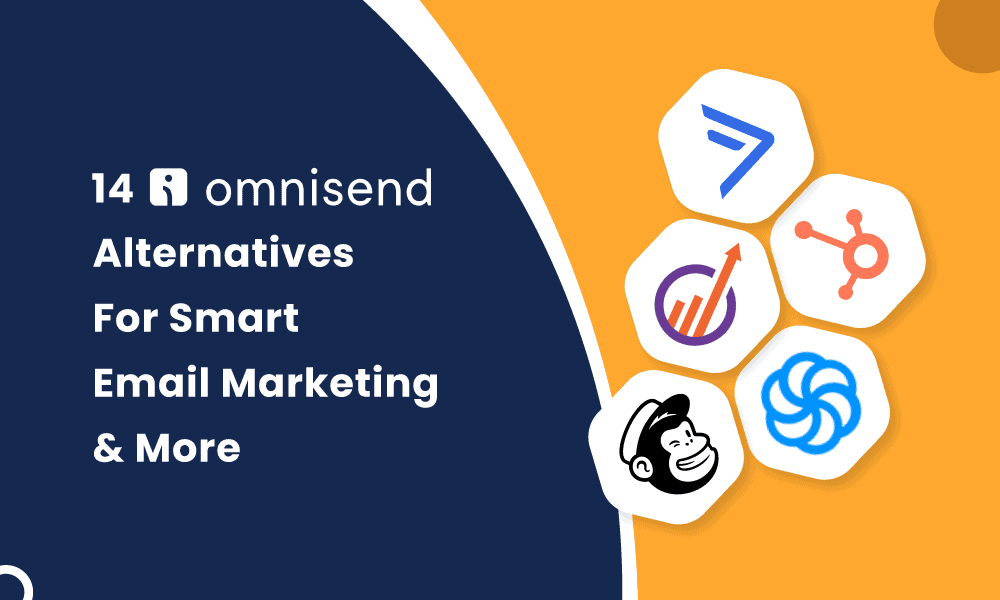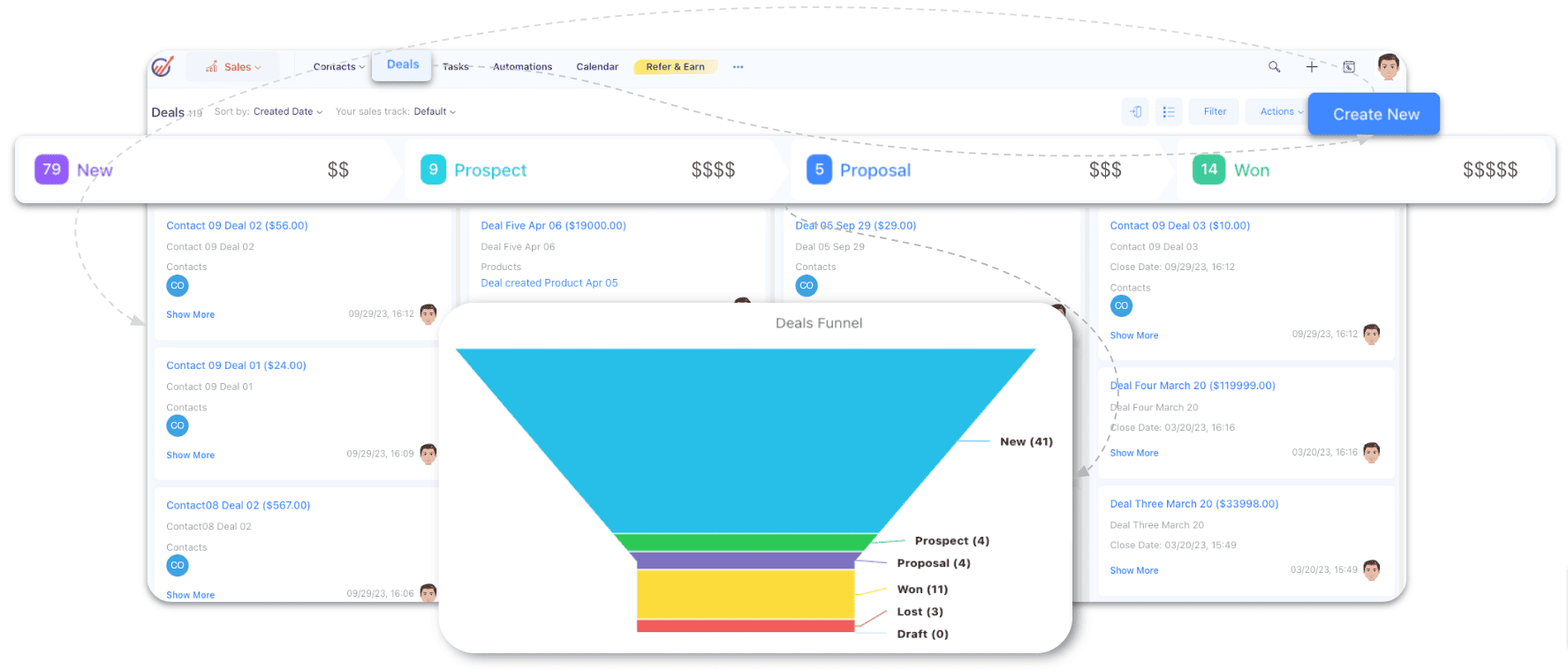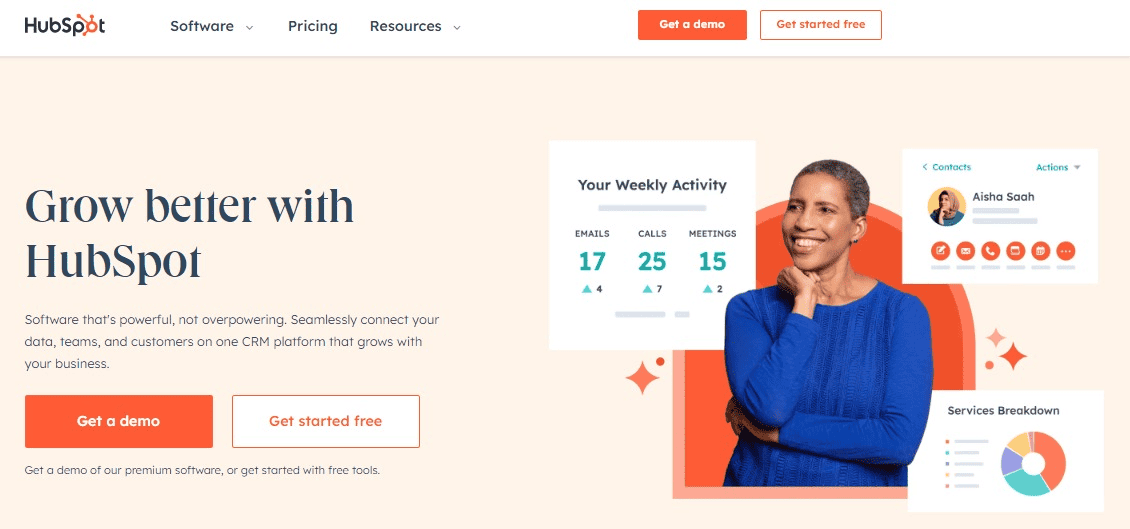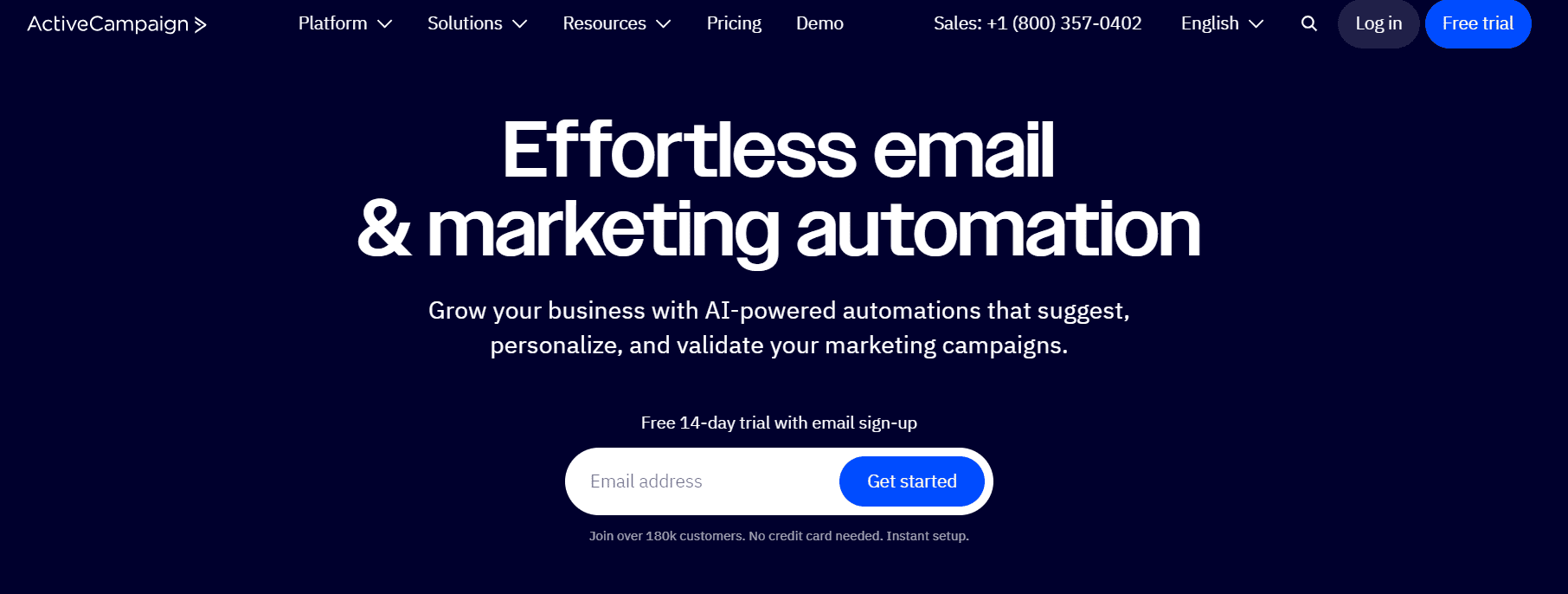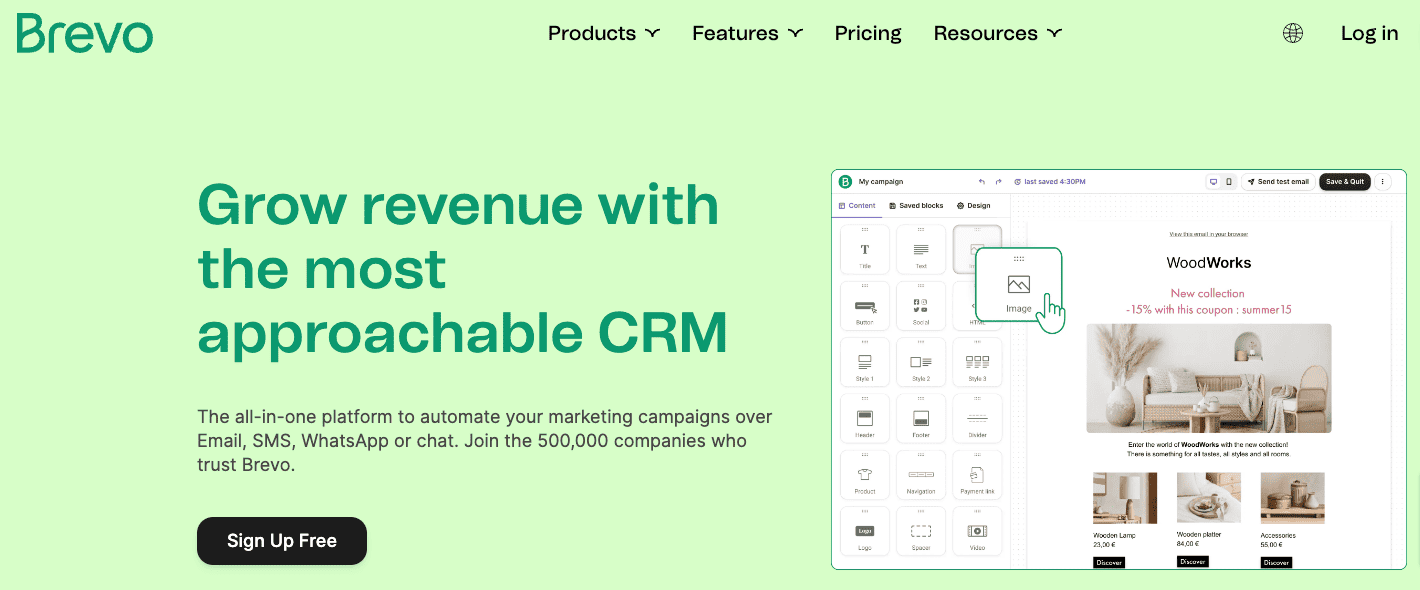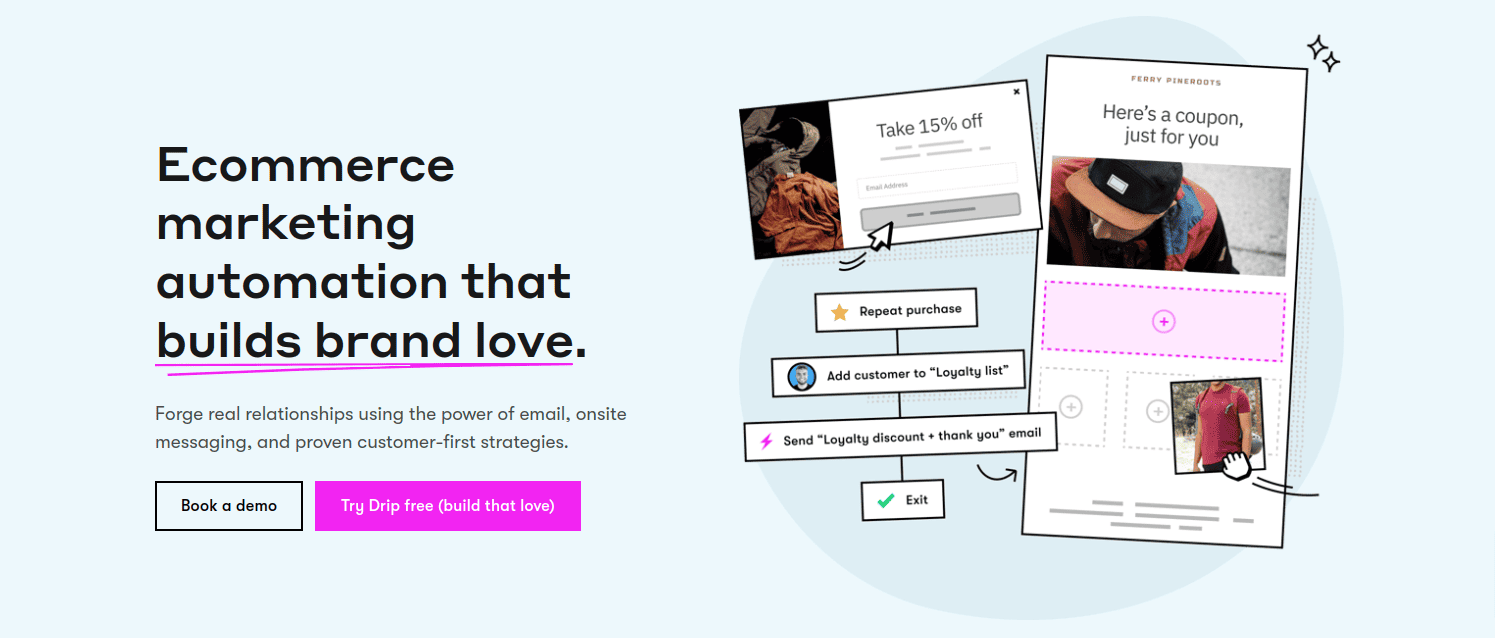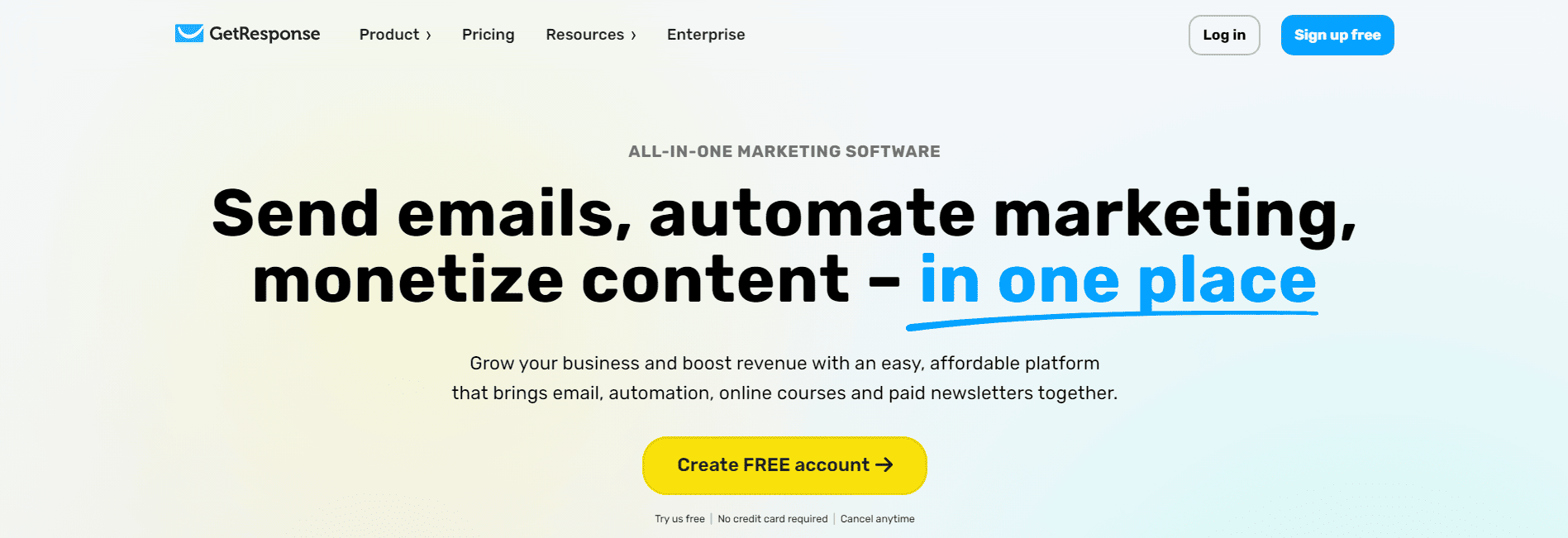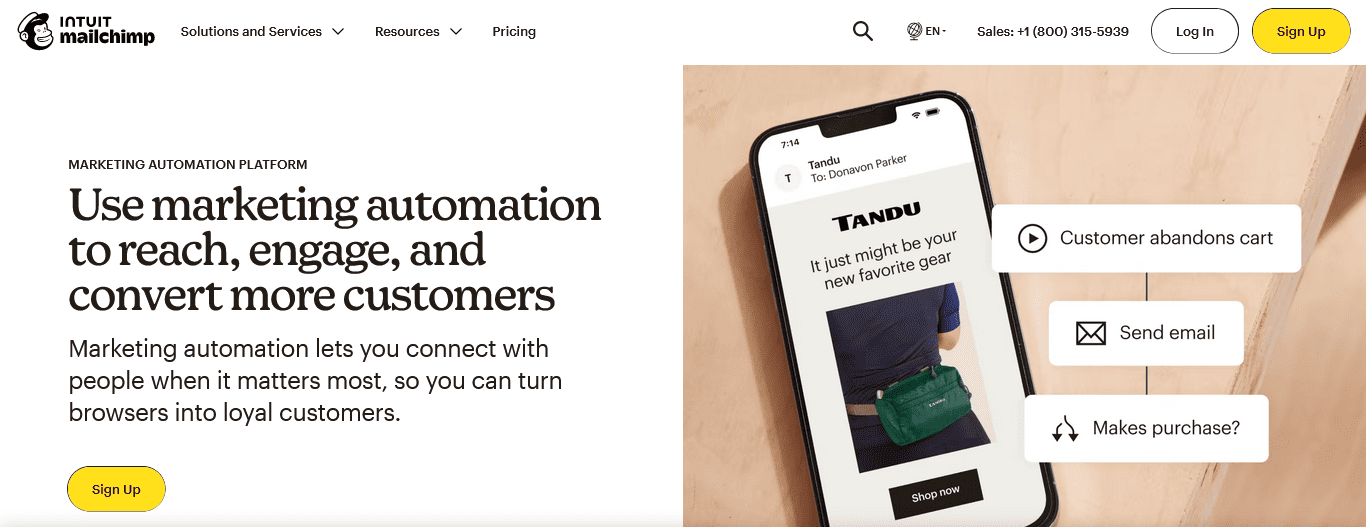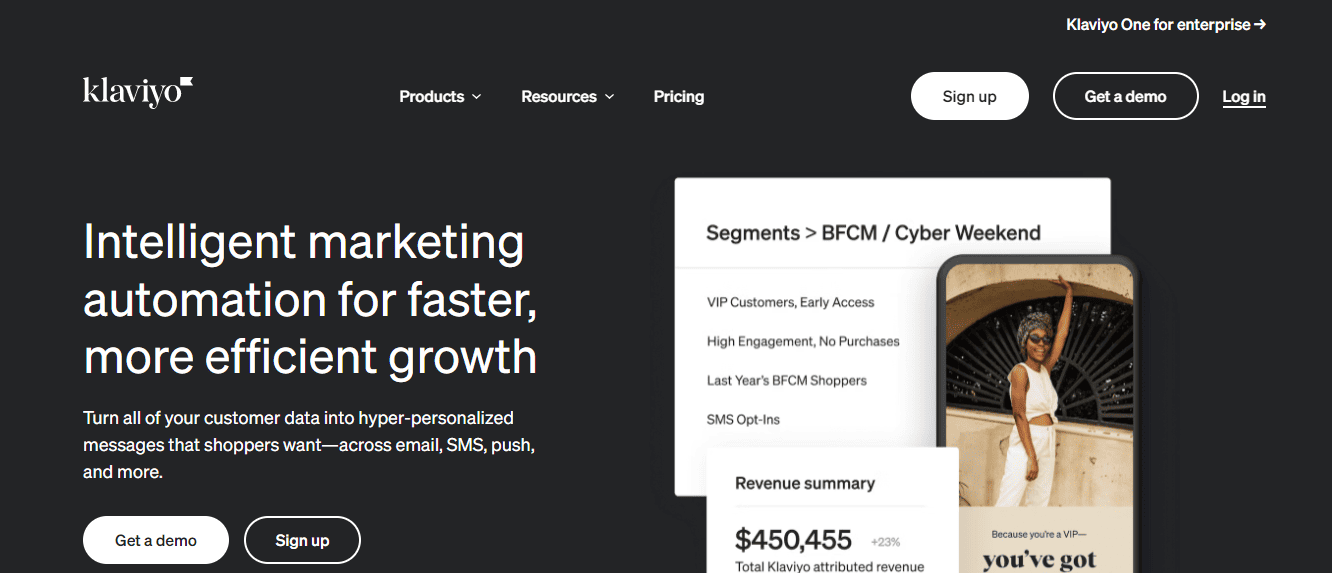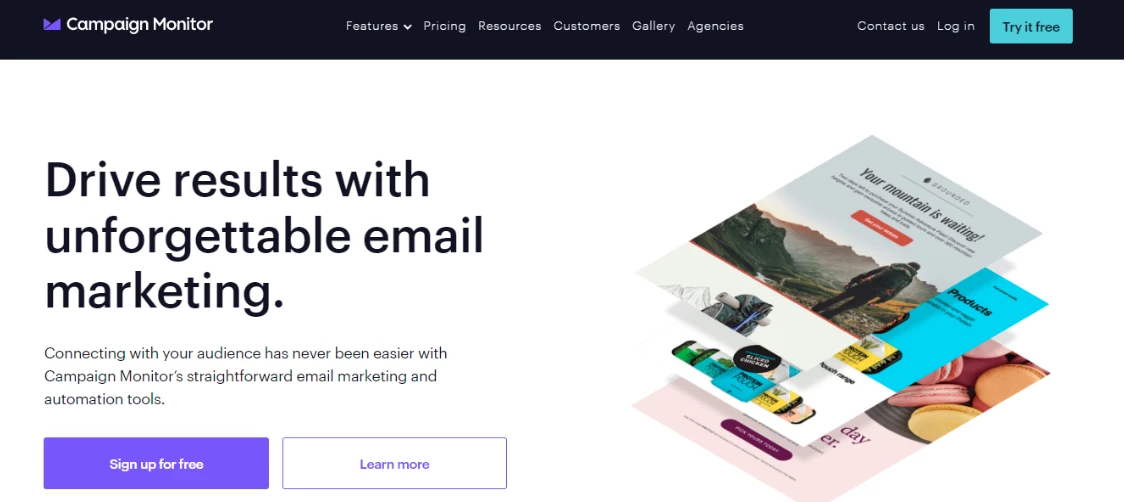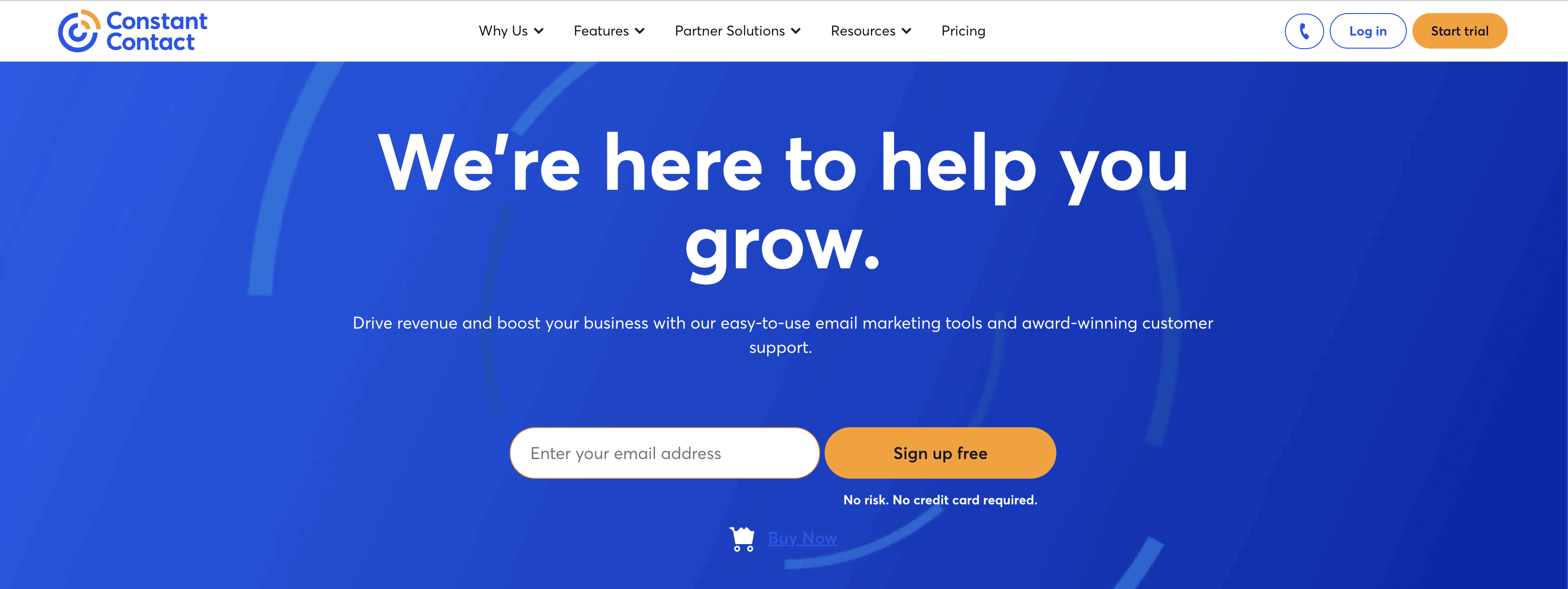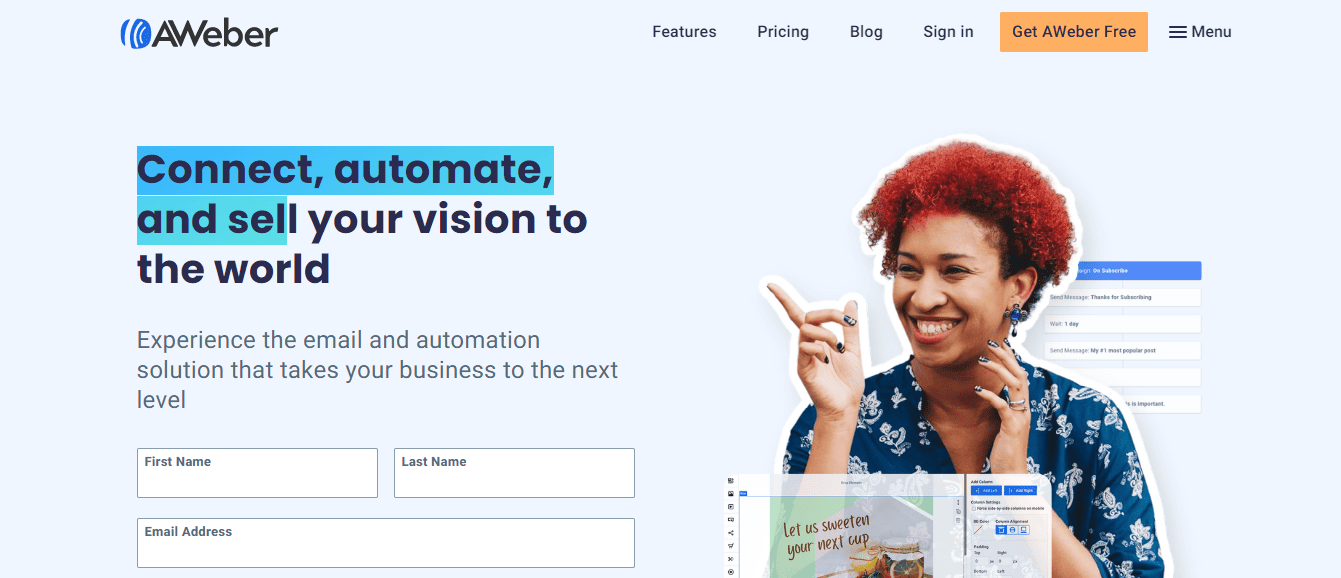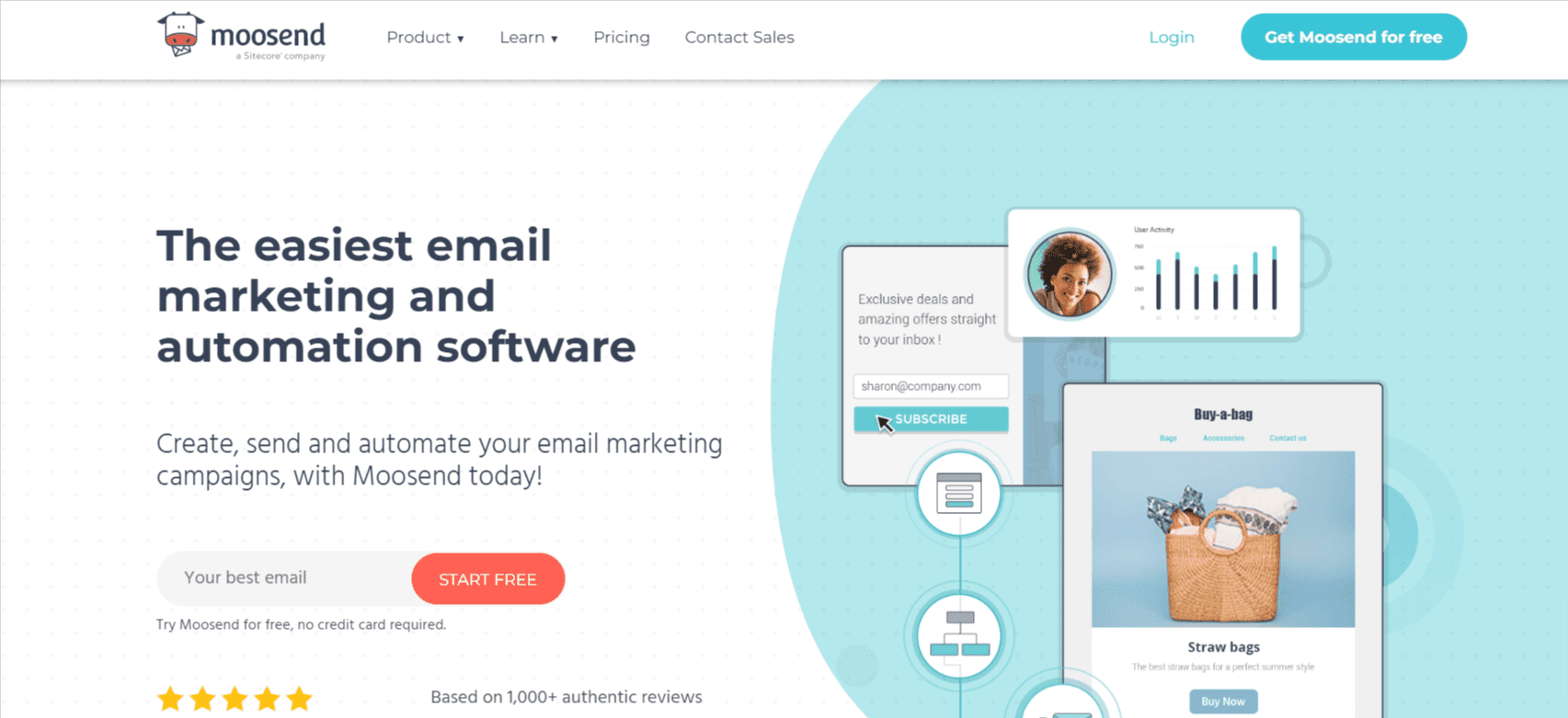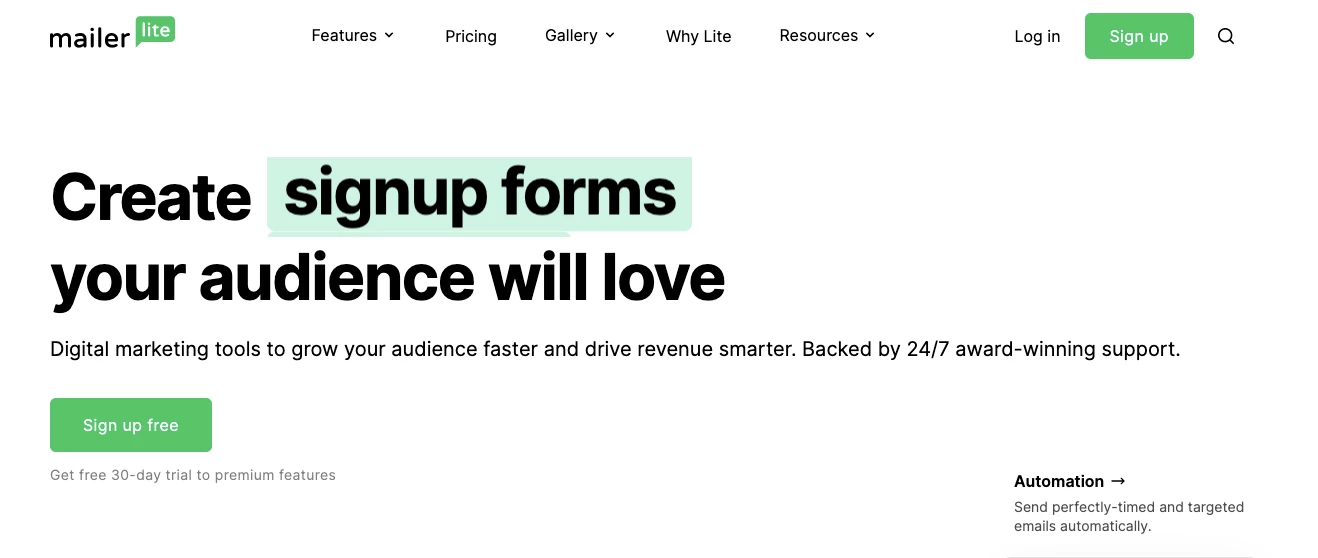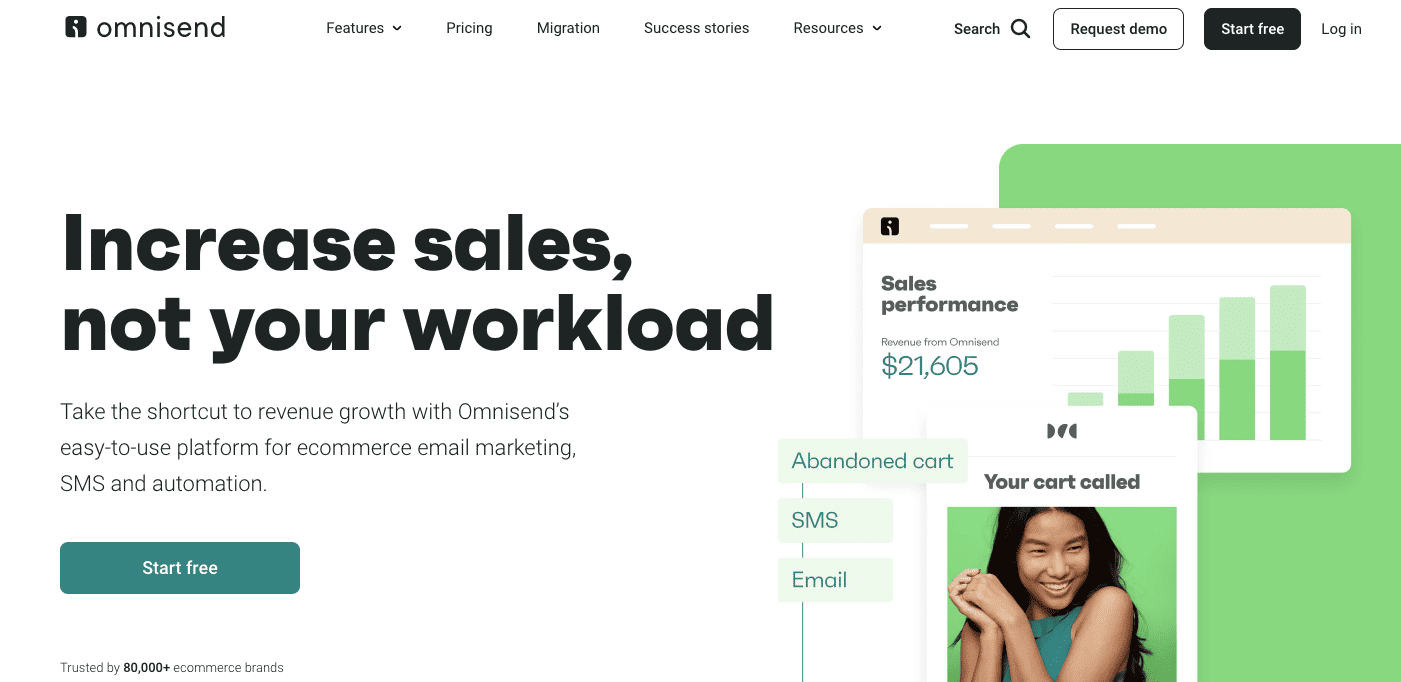Omnisend is more than just an email marketing tool — it also integrates SMS and web push notification channels.
Omnisend excels at serving online stores — its features are heavily tailored for eCommerce use cases. This means businesses outside the eCommerce space, or those looking for more flexibility, might find it limiting.
If you’re searching for a platform that better fits your needs, here are some of the top Omnisend alternatives to consider.
This guide will compare features, pricing, and integrations to help you shortlist the best option for your business.
Table of Contents
14 Top Omnisend Alternatives That You Can Consider
| Omnisend alternatives | Starting price | Free plan | Free trial | G2 ratings |
| EngageBay | $12.99 per user paid monthly | Yes | 14 days | 4.7/5 |
| HubSpot | $20 paid monthly (for 1,000 contacts) | Yes | 14 days | 4.4/5 |
| ActiveCampaign | $15 paid monthly (for 1,000 contacts) | No | 14 days | 4.4/5 |
| Brevo (formerly Sendinblue) | $9 paid monthly (for 500 contacts) | Yes | 14 days | 4.5/5 |
| Drip | $39 paid monthly (for 2,500 contacts) | No | 14 days | 4.4/5 |
| GetResponse | $19 paid monthly (for 1,000 contacts) | No | 30 days | 4.3/5 |
| Mailchimp | $8.87 paid monthly (for 500 contacts) | Yes | NA | 4.3/5 |
| Klaviyo | $30 paid monthly (for 1,000 contacts) | Yes | NA | 4.5/5 |
| Campaign Monitor | $44 paid monthly (for 1,000 contacts) | Yes | 30 days | 4.1/5 |
| Constant Contact | $30 paid monthly (for 1,000 contacts) | No | 30 days | 4.0/5 |
| AWeber | $25 paid monthly (for 1,000 contacts) | Yes | NA | 4.2/5 |
| Kit (formerly ConvertKit) | $29 paid monthly (for 1,000 contacts) | Yes | 14 days | 4.4/5 |
| Moosend | $16 paid monthly (for 1,000 contacts) | No | 30 days | 4.7/5 |
| MailerLite | $15 paid monthly (for 1,000 contacts) | Yes | 30 days | 4.6/5 |
Let’s look at Omnisend alternatives in detail now.
1. EngageBay
Best affordable all-in-one automation platform
- Ratings (as per G2): 4.75/5
- Starting price: $12.99 per user paid monthly
- Free trial length: 14 days
Why you should pick EngageBay
EngageBay is a powerful marketing automation tool packed with robust features. Its free CRM lets you effortlessly pull contacts from various sources and launch email campaigns with ease.
With an intuitive drag-and-drop editor, you can customize pre-designed templates or create your own from scratch. EngageBay also provides a library of 1,000+ email templates for different use cases — cart abandonment, welcome series, apology emails, and more.
Designing and automating drip email campaigns is seamless, thanks to EngageBay’s versatile triggers for marketing, sales, and customer service automation.
Beyond email marketing, EngageBay offers a comprehensive suite of tools, including a landing page builder, web forms, email broadcasts, automated sequences, and a reporting dashboard. If you’re looking for an all-in-one solution at an affordable price EngageBay is worth considering.
A quick take on EngageBay
Pricing: EngageBay offers a forever-free plan with up to 250 contacts and 1,000 branded emails. Paid plans start at $12.99 per user per month for the marketing platform, while the all-in-one suite starts at $14.99 per user per month. Annual billing comes with an 8% discount.
Customer support: EngageBay offers reliable customer support across all plans, including email and live chat. Paid users get additional perks like free onboarding and a dedicated account manager, while phone support is exclusively available on the highest-tier PRO plan.
Integrations: EngageBay offers seamless one-click integrations with popular tools like Sendgrid, Zapier, Mailgun, and more to help expand your business functionalities.
| Pros | Cons |
|
|
2. HubSpot
Best for inbound marketing
- Ratings (as per G2): 4.4/5
- Starting price: $20 paid monthly (for 1,000 contacts)
- Free trial length: 14 days
Why you should pick HubSpot
HubSpot offers free email marketing tools with essential features like a user-friendly drag-and-drop editor, customizable email templates, and basic reporting capabilities.
However, if you need advanced features like detailed reporting, A/B testing, and marketing automation, you’ll have to upgrade to its Professional or Enterprise plan — which can be quite expensive and may not be ideal for small businesses.
That said, if you’re a solopreneur or a small business with basic email marketing needs, HubSpot is a great choice. It’s known for its high email deliverability and offers a variety of goal-oriented templates, including email newsletters, birthday outreach, and more.
A quick take on HubSpot
Pricing: HubSpot offers a free plan with a 2,000-email sending limit. Paid plans start at $20 per month and scale up to $3,600 per month, with email sending limits set at 5x, 10x, or 20x your marketing contacts, depending on the plan you choose.
Customer support: HubSpot offers email and in-app support across all its paid plans, while phone support is reserved for Professional and Enterprise users. Additionally, Marketing Hub users benefit from multi-language support, making it easier to get assistance in their preferred language.
Integrations: HubSpot offers 100+ seamless integrations with popular platforms, enabling businesses to connect their favorite tools effortlessly. However, integration compatibility varies by plan, so higher-tier subscriptions may provide access to more advanced integrations.
| Pros | Cons |
|
|
3. ActiveCampaign
Best for advanced automation needs
- Ratings (as per G2): 4.5/5
- Starting price: $15 paid monthly (for 1,000 contacts)
- Free trial length: 14 days
Why you should pick ActiveCampaign
Unlike some Omnisend alternatives, ActiveCampaign offers a versatile set of tools across its plans. While Omnisend is heavily geared toward eCommerce, ActiveCampaign caters to a broader range of industries, including eCommerce, B2B companies, and digital businesses.
ActiveCampaign combines three powerful automation tools — email marketing, marketing automation, and CRM. It allows you to send one-time email broadcasts to your entire contact list or set up automated email sequences triggered by customer actions throughout their journey.
Additionally, ActiveCampaign provides access to deal pipelines and sales automation software as an optional add-on, making it a well-rounded solution for businesses looking to streamline both marketing and sales processes.
A quick take on ActiveCampaign
Pricing: ActiveCampaign’s pricing starts at $15 per month for 1,000 contacts, including email templates and up to five automations. For advanced features, the Plus plan begins at $49 per month, with an optional CRM add-on for $95 per month. Enterprise users can access premium functionality at $145 per month for 1,000 contacts.
Customer support: ActiveCampaign provides email and chat support across all plans, along with onboarding assistance to help users get started. However, priority support is only available on Pro and Enterprise plans. Additionally, its live training sessions ensure users can maximize the platform’s features effectively.
Integrations: ActiveCampaign stands out with its 900+ integrations, including standard eCommerce platforms, making it easy to streamline your online business operations.
| Pros | Cons |
|
|
4. Brevo (formerly Sendinblue)
Best for bulk email sending
- Ratings (as per G2): 4.5/5
- Starting price: $9 paid monthly (for 500 contacts)
- Free trial length: NA
Why you should pick Brevo
Brevo is a great alternative to Omnisend if you don’t want a daily email send limit. Instead of a fixed cap, you can purchase email credits as needed, with no expiration date — making it ideal for businesses that send bulk emails.
Like Omnisend, Brevo offers SMS marketing. However, web and mobile push notifications, as well as pop-ups, are available only as add-ons for multi-channel marketing.
Brevo also stands out with its heat map reporting, though this feature is limited to the Enterprise plan. Additionally, you can create personalized content using dynamic emails and set up advanced segmented lists for highly targeted campaigns.
A quick take on Brevo
Pricing: Brevo offers four pricing plans: Free, Lite, Premium, and Enterprise. The Free plan allows up to 300 emails per day, while paid plans start at $9 per month for up to 500 contacts with no daily sending limit. Plus, you can enhance functionality with various add-ons to suit your needs.
Customer support: Brevo offers customer support in six languages via email, live chat, and social media. While all users, including those on the free plan, have access to 24/7 support, phone assistance is reserved for Business and Enterprise plan subscribers.
Integration: Brevo integrates seamlessly with popular eCommerce platforms, CRMs, and business tools, allowing you to sync customer data and automate workflows effortlessly.
| Pros | Cons |
|
|
5. Drip
Best for promoting an online store
- Ratings (as per G2): 4.4/5
- Starting price: $39 paid monthly (for 2,500 contacts)
- Free trial length: 14 days
Why you should pick Drip
Drip is a powerful Omnisend alternative designed specifically for eCommerce businesses. It combines customer insights and behavioral data from your store, marketing channels, and integrations to send targeted, personalized emails that keep shoppers coming back.
Beyond advanced workflow automation, Drip allows you to sync Facebook Custom Audiences with Drip segments, ensuring your marketing campaigns stay aligned across multiple channels.
Its easy-to-use point-and-click builder allows you to insert store products into emails, showcase bestsellers to new customers, and send dynamic content like cart URLs — helping you boost conversions effortlessly.
A quick take on Drip
Pricing: Drip’s pricing starts at $39 per month for up to 2,500 contacts, scaling based on list size and email volume. Plans go up to $1,999 per month for 180,000 contacts, with custom pricing available for larger lists. There are no hidden fees, making it a transparent and scalable option for growing businesses.
Customer support: Drip provides reliable customer support for paying users, offering email support Monday to Friday from 9 AM to 5 PM CT. Subscribers on plans of $99 per month or higher also get access to live chat support during the same hours.
Integrations: Drip offers over 100 integrations, with a strong emphasis on eCommerce tools.
| Pros | Cons |
|
|
6. GetResponse
Best for advanced marketing needs
- Ratings (as per G2): 4.3/5
- Starting price: $19 paid monthly (for 1,000 contacts)
- Free trial length: 30 days
Why you should pick GetResponse
What makes GetResponse a powerful alternative to Omnisend is its extensive set of features, catering not just to eCommerce businesses but also to creators. For instance, it allows creators to easily build and sell courses, host webinars, and more.
Similarly, marketers running an online business can integrate their store, automate event-based triggered emails, set up purchase automation, and leverage dynamic segmentation.
Whether you’re just starting out, a seasoned marketer, or a creator, GetResponse offers a plan tailored to your needs. What truly sets it apart is that it doesn’t limit the number of emails you can send.
A quick take on GetResponse
Pricing: GetResponse offers four paid plans — Starter, Marketer, Creator, and Enterprise — starting at $19 per month for up to 1,000 contacts. The Enterprise plan provides custom pricing and advanced features tailored for large businesses.
Customer support: GetResponse provides 24/7 live chat and email support across all plans, ensuring quick assistance when needed. Phone support and Slack integration are available with the Enterprise plan, which also includes dedicated onboarding for a more personalized experience.
Integrations: GetResponse supports 170+ integrations across various popular apps such as Stripe, X, Zapier, and more — allowing you to connect with your favorite tools effortlessly. You can also use their advanced API to create custom integrations tailored to your needs.
| Pros | Cons |
|
|
7. Mailchimp
Best for email personalization
- Ratings (as per G2): 4.3/5
- Starting price: $8.87 paid monthly (for 500 contacts)
- Free trial length: NA
Why you should pick Mailchimp
Mailchimp is a powerful email marketing tool that excels at helping users send highly personalized, targeted campaigns. It offers a comprehensive audience management system, including a marketing CRM, behavioral targeting, predictive demographics, and more — making it easy to segment audiences and run tailored campaigns.
Mailchimp surveys help you gather valuable data on demographics, customer satisfaction, and more. You can target specific contacts, apply tags based on their responses, and seamlessly connect surveys to emails and other communication channels for streamlined engagement.
What’s more, Mailchimp is known for its ability to create customer journeys and automate campaigns for maximum effectiveness. Plus, its custom-coded email templates let you design highly personalized, branded emails that stand out.
A quick take on Mailchimp
Pricing: Mailchimp’s free plan includes up to 1,000 emails per month for 500 contacts. Paid plans start at $8.87 per month (or $4.43 per month with annual billing) and come in three tiers: Essentials, Standard, and Premium. Mailchimp also offers a flexible pay-as-you-go option for businesses with occasional email needs.
Customer support: Mailchimp provides only email support for the first 30 days on its free plan. Essential and Standard plan users get 24/7 live chat and email support, while phone and priority support are exclusive to Premium plan subscribers.
Integrations: Mailchimp offers quick integrations with 300+ business apps like WooCommerce, BigCommerce, ShopSync, Magento, Zapier, and more.
| Pros | Cons |
|
|
8. Klaviyo
Best for unified, cross-channel campaigns
- Ratings (as per G2): 4.6/5
- Starting price: $30 paid monthly (for 1,000 contacts)
- Free trial length: NA
Why you should pick Klaviyo
Klaviyo is a powerful email marketing automation platform built for real-time segmentation and personalization, ensuring precise audience targeting. It seamlessly integrates your marketing channels and data sources to provide a comprehensive view of your customer profiles.
With its cross-channel capabilities, you can combine email, SMS, and push notifications within the same automated flow. It enhances campaign efficiency and maximizes ROI.
It also offers 60+ pre-built automation templates — covering essential email sequences like welcome series, cart abandonment, and post-purchase follow-ups. You just need to customize and launch.
For deeper insights, Klaviyo lets you build customizable dashboards. It gives you full control over which metrics to track and how to visualize your data.
A quick take on Klaviyo
Pricing: Klaviyo’s pricing is based on the number of contacts in your database. It offers a Free plan for up to 250 contacts, including 500 email sends and 150 SMS/MMS credits per month. Paid plans start at $30 per month for up to 1,000 contacts, with higher-tier pricing as your subscriber list grows.
Customer support: Klaviyo offers 24/7 email support, though free accounts can access it only for the first 60 days. Live chat support is available 24/5, with weekend and holiday availability depending on your plan.
Integrations: Klaviyo offers 350+ pre-built integrations and flexible APIs. It connects seamlessly with a variety of eCommerce platforms like Shopify and WooCommerce, CRMs, and other marketing tools.
| Pros | Cons |
|
|
9. Campaign Monitor
Best for integrating loyalty programs
- Ratings (as per G2): 4.1/5
- Starting price: $44 paid monthly (for 1,000 contacts)
- Free trial length: 30 days
Why you should pick Campaign Monitor
Campaign Monitor is a good alternative to Omnisend, especially for businesses looking for advanced automation and subscriber segmentation. Its automated journeys include features like a points-based loyalty program, allowing brands to reward customer engagement effortlessly.
What’s more, it recently introduced Wait Until Scheduling functionality that offers greater control over automated emails. It ensures the emails reach subscribers at the most optimal times.
Additionally, Campaign Monitor automatically categorizes subscribers into six pre-built engagement segments, making it easier to monitor interactions and send highly personalized content.
A quick take on Campaign Monitor
Pricing: Campaign Monitor offers a free plan for up to 500 contacts, valid for 30 days. After that, users can choose from three paid plans: Lite, Essentials, and Premier. The Lite plan starts at $44 per month for 1,000 contacts, while the Premier plan is priced at $169 per month. Both the Essentials and Premier plans come with unlimited email sends — ideal for high-volume email marketing needs.
Customer support: Campaign Monitor offers email support for all plans, while phone support is exclusive to Premier plan users. Additionally, it provides valuable resources, including training videos, deliverability support, and design and spam testing.
Integrations: Campaign Monitor seamlessly integrates with various tools, including billing platforms, survey tools, CRMs, and eCommerce solutions for efficient business operations.
| Pros | Cons |
|
|
10. Constant Contact
Best for handling event marketing
- Ratings (as per G2): 4.0/5
- Starting price: $30 paid monthly (for 1,000 contacts)
- Free trial length: 30 days
Why you should pick Constant Contact
Constant Contact stands out as an Omnisend alternative with its robust event management and promotion capabilities. It provides all the essential tools to create, promote, and manage events directly through email campaigns — ideal for businesses that host webinars, workshops, or live events.
Beyond email marketing, Constant Contact also supports omnichannel marketing. It integrates eCommerce platforms, social media, and SMS marketing — helping businesses reach customers wherever they are. However, SMS marketing is currently limited to U.S. audiences.
With a wide range of customizable email templates, Constant Contact makes it easy to design and send professional emails that engage your audience effectively.
A quick take on Constant Contact
Pricing: Constant Contact’s pricing starts at $30 per month, reaching up to $110 per month for 1,000 contacts. While its Lite plan includes event management tools, it lacks essential email marketing features, making it less suitable for growing businesses.
Customer support: Constant Contact offers customer support across all plans, including self-service resources, live chat, and phone support. Premium users also get dedicated, priority support for faster assistance and personalized service.
Integrations: Constant Contact supports over 300 integrations with your favorite tools. Its integration with Canva and Vimeo helps create impactful email designs for enhanced engagement.
| Pros | Cons |
|
|
11. AWeber
Best for creators with a large audience
- Ratings (as per G2): 4.2/5
- Starting price: $25 paid monthly (for 1,000 contacts)
- Free trial length: NA
Why you should pick AWeber
AWeber stands out as an email marketing platform with its ability to send bulk emails efficiently. Each plan allows unlimited subscribers, with a monthly cap of 10x to 15x the subscriber volume — making it ideal for creators looking to grow a large audience.
It’s best suited for creators, offering tools to run online courses, manage subscriptions, and sell products directly through email.
AWeber also features purchase tagging, which helps segment audiences and personalize campaigns.
Its premium plans provide advanced insights, including audience and account analytics, webpage tracking, and email sales tracking.
A quick take on AWeber
Pricing: AWeber offers a free plan with a limit of 3,000 emails per month. Paid plans start at $25 per month (Lite) for 1,000 contacts, with higher-tier plans reaching $899 per month (Unlimited) for creators with 100,000+ subscribers. Choosing annual billing can save you up to four months’ worth of fees.
Customer support: AWeber offers chat and email support on all plans, while phone support is available for paid users. Plus and Unlimited plan subscribers get priority support, with the Unlimited plan also including free migration and personalized account management.
Integrations: AWeber stands out with its seamless integration with 100+ platforms like Shopify, WordPress, Facebook, WooCommerce, and PayPal. Moreover, its robust API makes it easy to connect with any of your existing or favorite tools
| Pros | Cons |
|
|
12. Kit (formerly ConvertKit)
Best for selling digital products
- Ratings (as per G2): 4.4/5
- Starting price: $29 paid monthly (for 1,000 contacts)
- Free trial length: 14 days
Why you should pick Kit
If you’re a creator looking to sell digital products, Kit is a standout alternative to Omnisend. Designed specifically for creators, it goes beyond standard email marketing by offering intuitive tools that simplify selling and audience engagement.
Kit provides professionally designed email and landing page templates, along with automation tools to help you launch and scale your business effortlessly. Its unique features — personalized recommendations, a creator profile, and the Creator Network — make it easier to connect with the right audience and grow your brand.
One of Kit’s biggest advantages is its seamless email commerce feature, allowing readers to purchase products directly from your emails. This means fewer steps in the buying process, leading to higher conversions and more sales.
A quick take on Kit
Pricing: Kit offers a free Newsletter plan for up to 10,000 subscribers. Paid plans start at $29 per month (Pros) and $59 per month (Pro Creator), both covering up to 1,000 contacts with unlimited email sends. Opting for annual billing saves you the cost of two months.
Customer support: Kit provides 24/7 customer support and access to its Creator University with all plans. Pro creators benefit from priority support and a free migration service for those with over 5,000 subscribers, making the transition smooth and hassle-free.
Integrations: Kit offers over 100 direct integrations with membership platforms, affiliate management systems, course tools, and more. Plus, its detailed API documentation allows for custom integrations to fit your unique needs.
| Pros | Cons |
|
|
13. Moosend
Best for pre-built automation
- Ratings (as per G2): 4.7/5
- Starting price: $16 paid monthly (for 1,000 contacts)
- Free trial length: 30 days
Why you should pick Moosend
Moosend is a powerful email marketing automation platform that caters to a wide range of industries — not just eCommerce. If you’re looking for a flexible tool with advanced automation, Moosend is worth considering.
Its automation tool offers numerous triggers and four different conditional steps, allowing you to create highly customized workflows. With AI-powered marketing automation, you can segment customers automatically, send abandoned cart reminders, and include clickable links to drive traffic to your website.
Moosend also simplifies email design with its intuitive editor and image picker, helping you select the perfect image or GIF to enhance engagement. Plus, its reporting dashboard lets you create custom reports, track key metrics, and visualize data with over 40 insightful widgets.
A quick take on Moosend
Pricing: Moosend paid plans start at $16 per month (Pro) for 1,000 contacts, with custom pricing available for higher tiers (Enterprise). For running high-volume email campaigns, you can purchase an Email Credits Bundle — starting at $350 for 350,000 email credits and scaling to $1,000 for 1,000,000 email credits.
Customer support: Moosend provides email support and live chat across all plans. Enterprise users get priority support and a dedicated account manager, while Moosend+ subscribers have the option to add an account manager for additional assistance.
Integrations: Moosend offers over 100 integrations and API access across all its plans to help you connect your favorite tools and customize your workflows effortlessly.
| Pros | Cons |
|
|
14. MailerLite
Best for running eCommerce and newsletters
- Ratings (as per G2): 4.6/5
- Starting price: $15 paid monthly (for 1,000 contacts)
- Free trial length: 30 days
Why you should pick MailerLite
MailerLite offers a feature-rich email marketing platform with powerful customization and automation tools. Its intuitive drag-and-drop editor makes it easy to create personalized email templates, while the built-in image library provides free visuals to enhance your campaigns.
Plus, it seamlessly integrates with eCommerce platforms like WooCommerce and Shopify, allowing you to run targeted campaigns and automate workflows effortlessly.
Beyond email marketing, MailerLite equips you with all the essential tools for managing newsletters and subscriptions. Its advanced reporting dashboard helps track everything — from social media performance to eCommerce conversions — giving you valuable insights into your campaigns.
Additionally, the email list verifier tool lets you check and verify thousands of email addresses in real-time, reducing duplicates and fake IDs to improve your deliverability rate.
A quick take on MailerLite
Pricing: MailerLite’s free plan is limited to 1,000 contacts and allows 12,000 monthly email sends. Its paid plans start at $15 per month for 1,000 contacts, with custom pricing available for businesses exceeding 100,000 subscribers.
Customer support: MailerLite offers email support for all users, though it’s only valid for 30 days on the free plan. Paid subscribers receive 24/7 priority support, while live chat support is exclusively available for Advanced plan users.
Integrations: MailerLite supports over 150 integrations with popular tools to streamline your business operations.
| Pros | Cons |
|
|
What To Look for in an Omnisend Alternative?
When choosing an Omnisend alternative, consider the following key factors to ensure it aligns with your business needs.
Industry fit
Omnisend is designed specifically for eCommerce businesses, which means its features, landing pages, and email templates are optimized for online stores.
If you’re in a different industry or need a more versatile option, choose a platform that caters to a broader range of businesses. The right alternative will provide industry-specific templates and automation tools, saving you time and improving conversion rates.
Multi-channel marketing
If you want to expand beyond SMS and web push notifications, look for an email marketing platform that integrates with additional channels, such as social media, loyalty programs, or event marketing.
For example, Campaign Monitor is an excellent choice for integrating loyalty programs with email campaigns, while Constant Contact is ideal for event marketing.
Ease of use
A user-friendly interface with an intuitive drag-and-drop editor can simplify campaign execution.
While Omnisend is known for its ease of use, it’s important to take demos of shortlisted alternatives to compare their navigation, dashboard customization, and overall user experience.
The best platform should make it easy to create, manage, and optimize email campaigns effortlessly.
Pricing & scalability
Budget is a crucial factor when selecting an Omnisend alternative. Compare pricing plans to ensure they offer the best value for the features provided.
Also, consider whether the platform allows for seamless scaling as your business grows — without unexpected costs that could strain your budget.
Customer support
Customer support is often overlooked, but having access to reliable assistance can make a significant difference when troubleshooting issues.
Look for platforms that offer 24/7 live chat, email support, and a comprehensive knowledge base to ensure you get the help you need when you need it.
Is Omnisend the Best Email Marketing Platform for Your Business?
Omnisend is a powerful email marketing platform designed specifically for eCommerce businesses. It seamlessly integrates email campaigns with SMS and web push notifications, enabling you to connect with customers across multiple touchpoints.
If you’re a Shopify store owner, Omnisend also allows you to collect product reviews via email or text after a purchase, helping you build trust and improve conversions.
With 130+ integrations and a strong customer base of over 125,000 eCommerce brands, Omnisend is a go-to choice for streamlining your business marketing automation.
Omnisend pricing
Omnisend offers a free plan for up to 250 contacts, providing access to all its core features.
- Standard Plan: Starts at $20 per month for 1,000 contacts.
- Pro Plan: Starts at $59 per month for 1,000 contacts.
The key difference between plans lies in the number of emails, SMS, web push notifications, and product review credits included.
Omnisend pros & cons
Pros
- 250+ professionally designed email templates for eCommerce use cases like cart abandonment, welcome emails, and promotional campaigns
- Pre-built automation workflows & segmentation to save time and effort
- Detailed sales & performance reports essential for eCommerce businesses
Cons
- The user interface and help guide can be confusing for beginners
- No phone support — only email and chat assistance are available
Wrap Up
Finding the right Omnisend alternative depends on your business needs — whether you’re looking for better multi-channel marketing, more flexibility beyond eCommerce, or a platform that fits your budget as you scale.
If you’re looking for an affordable yet powerful all-in-one automation platform, EngageBay is an excellent choice.
Unlike many other platforms that charge premium prices for automation, EngageBay offers email marketing, CRM, sales automation, and customer support tools — all in one place — at a fraction of the cost.
Plus, its intuitive interface and rich feature set make it a great fit for businesses of all sizes.
No matter which platform you choose, the goal is to create personalized, high-converting email campaigns that engage your audience and drive revenue. Start with a free trial of EngageBay today.
Frequently Asked Questions
1. What are the best Omnisend alternatives in 2024?
Some of the best Omnisend alternatives in 2024 include EngageBay, Moosend, MailerLite, Klaviyo, and Drip. These platforms offer robust email marketing automation, multi-channel support, and flexible pricing to suit different business needs.
2. Which email marketing tool is most suitable for eCommerce businesses?
Omnisend, Klaviyo, and Drip are among the top choices for eCommerce businesses. They offer advanced automation, pre-built workflows for abandoned carts and product recommendations, and deep integrations with platforms like Shopify and WooCommerce.
3. Are there free or affordable alternatives to Omnisend?
Yes! EngageBay, MailerLite, and Brevo offer free plans with essential features, while their paid plans are more affordable than Omnisend — making them great options for small businesses and startups.
4. How does Omnisend compare to tools like Klaviyo or Mailchimp?
Omnisend and Klaviyo are heavily focused on eCommerce, while Mailchimp caters to a broader audience. Klaviyo offers more advanced segmentation and analytics, while Omnisend includes SMS and web push notifications. Mailchimp is beginner-friendly but lacks deep eCommerce automation.
5. What features should I prioritize in an email marketing platform?
Look for automation, segmentation, ease of use, integrations, multi-channel marketing, and scalability. If you’re in eCommerce, features like abandoned cart recovery, product recommendations, and transactional emails are crucial.
